-
ARTÍCULO ORIGINAL31/07/2023
Parenting of mothers of children in early childhood during the COVID-19 pandemic: qualitative research
Revista Brasileira de Enfermagem. 2023;76:e20220478
Resumen
ARTÍCULO ORIGINALParenting of mothers of children in early childhood during the COVID-19 pandemic: qualitative research
Revista Brasileira de Enfermagem. 2023;76:e20220478
DOI 10.1590/0034-7167-2022-0478
Visualizações0Ver maisABSTRACT
Objectives:
to understand practices of mothers of children in early childhood who live in contexts of poverty in the face of the COVID-19 pandemic.
Methods:
an exploratory, descriptive and qualitative study. Participants were selected in the community context, composing an intentional sample to be collected through semi-structured online interviews. Data were analyzed inductively and anchored in the Bioecological Model of Human Development.
Results:
eight mothers participated in the research. Mothers highlighted pleasure in taking care of their children, although they were overloaded with activities and comprehensive care at the time of the pandemic. Children, in mothers’ perception, showed a higher frequency of challenging behaviors, which may be related to negative parenting practices, such as punishment and physical violence.
Final Considerations:
interventions to support parenting become urgent in the face of changes brought about by the COVID-19 pandemic in families living in a context of poverty.
-
ARTÍCULO ORIGINAL31/07/2023
Primary Health Care assessment in the COVID-19 pandemic from physicians’ and nurses’ perspective
Revista Brasileira de Enfermagem. 2023;76:e20220475
Resumen
ARTÍCULO ORIGINALPrimary Health Care assessment in the COVID-19 pandemic from physicians’ and nurses’ perspective
Revista Brasileira de Enfermagem. 2023;76:e20220475
DOI 10.1590/0034-7167-2022-0475
Visualizações0Ver maisABSTRACT
Objectives:
to assess the operationalization of Primary Health Care in the COVID-19 pandemic, according to Primary Care Assessment Tool: PCATool-Brasil attributes, from physicians’ and nurses’ perspective.
Methods:
a cross-sectional study, carried out with 99 physicians and nurses from Basic Health Units in a state in northeastern Brazil, with the aid of the adapted instrument PCATool-Brasil.
Results:
Essential Score was classified as high performance (6.6) and General Score as low performance (6.5). First Contact Access, Care Integration, and Community Guidance scores were <6.6. The best performances were attributed to the Longitudinality, Comprehensiveness and Family Guidance services (scores>6.6).
Conclusions:
the attributes of Primary Health Care, in general, showed values above or close to the cut-off point in the assessment. These data can support strategies for local and national managers to strengthen Primary Health Care in the COVID-19 pandemic and future public health emergencies.
-
31/07/2023
Breastfeeding prevalence in newborns of mothers with COVID-19: a systematic review
Revista Brasileira de Enfermagem. 2023;76:e20220173
Resumen
Breastfeeding prevalence in newborns of mothers with COVID-19: a systematic review
Revista Brasileira de Enfermagem. 2023;76:e20220173
DOI 10.1590/0034-7167-2022-0173
Visualizações0Ver maisABSTRACT
Objectives:
to compare exclusive breastfeeding prevalence versus artificial feeding in newborns of mothers with COVID-19.
Methods:
a systematic review of prevalence, according to JBI. Searches in PubMed®, Embase, CINAHL, LILACS and Web of Science™ databases in August 2021. Cross-sectional, longitudinal or cohort studies were selected, without language and time limitations that showed breastfeeding prevalence or that allowed calculation.
Results:
fifteen articles published in 2020 and 2021, cohort (60%) or cross-sectional (40%) were analyzed. The average of exclusive breastfeeding in mothers with COVID-19 was 56.76% (CI=39.90–72.88), and artificial breastfeeding, 43.23% (CI = 30.99 – 55.88), without statistically significant differences.
Conclusions:
despite the recommendations for maintaining breastfeeding, there was a reduction worldwide, when compared to periods prior to the pandemic. With advances in science, these rates have improved, showing the impact of evidence on practices. As limitations, study sources are cited. It is recommended to carry out new studies. PROSPERO registration CRD42021234486.
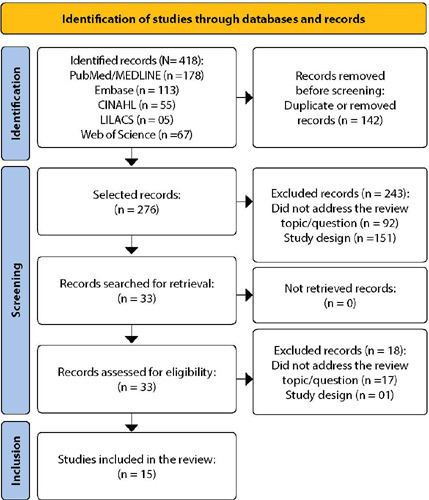
-
ARTÍCULO DE REVISIÓN10/07/2023
Metodología Lean Six Sigma para mejorar el proceso de alta en una unidad de cuidados intensivos
Revista Brasileira de Enfermagem. 2023;76(3):e20220538
Resumen
ARTÍCULO DE REVISIÓNMetodología Lean Six Sigma para mejorar el proceso de alta en una unidad de cuidados intensivos
Revista Brasileira de Enfermagem. 2023;76(3):e20220538
DOI 10.1590/0034-7167-2022-0538
Visualizações0RESUMEN
Objetivos:
describir el proceso de implementación de Lean Six Sigma para mejorar el proceso de alta en una unidad de cuidados intensivos brasileña.
Métodos:
estudio prospectivo siguiendo el método de desarrollo de proyectos denominado DMAIC (Define-Measure-Analyze-Improve-Control). Este método consta de cinco fases, a saber: definición del proyecto, medición del punto de partida y recolección de datos, análisis de resultados, mejora en los procesos y control estadístico.
Resultados:
la aplicación de la metodología Lean Six Sigma fue efectiva para mejorar el proceso de alta de la unidad de cuidados intensivos a la unidad de hospitalización. Esta mejora representó una reducción en el tiempo promedio de alta de 189 a 75 minutos, totalizando una mejora del 61%.
Conclusiones:
este artículo demuestra la efectividad de la aplicación de la metodología Lean Six Sigma para mejorar el flujo de descarga en una unidad crítica, lo que resulta en la reducción de tiempo y desperdicio.
Palavras-chave: Administración en SaludFlujo de TrabajoGestión de la CalidadMejoramiento de la CalidadUnidades de Cuidados IntensivosVer mais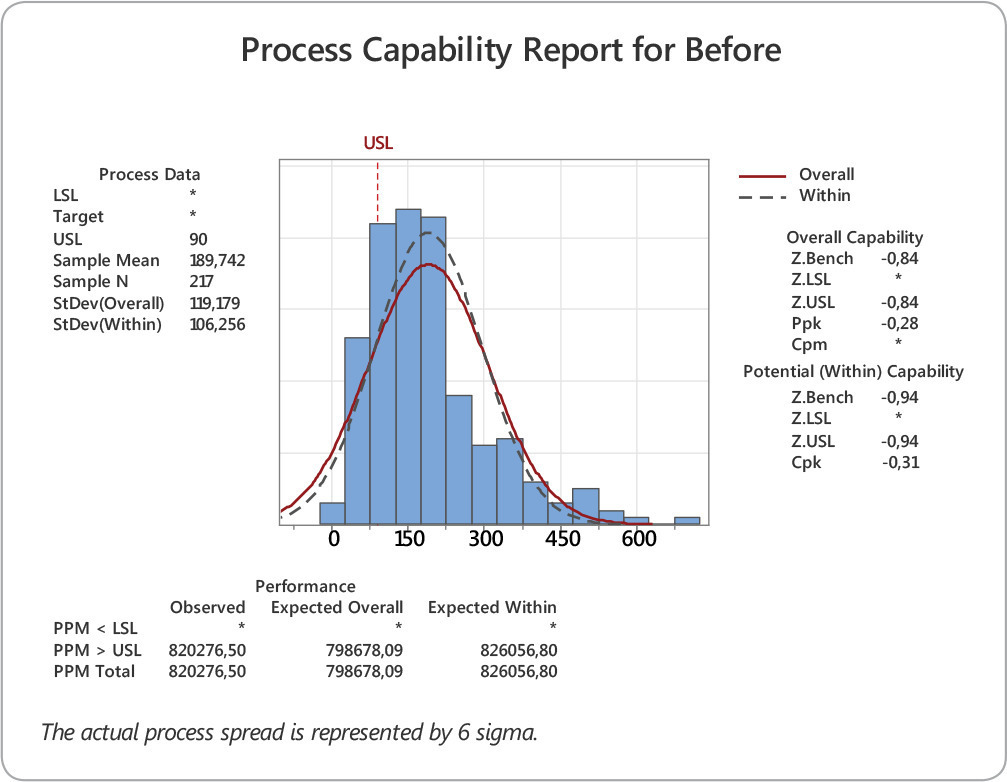
-
ARTÍCULO ORIGINAL10/07/2023
Occurrence and preventability of adverse events in hospitals: a retrospective study
Revista Brasileira de Enfermagem. 2023;76(3):e20220025
Resumen
ARTÍCULO ORIGINALOccurrence and preventability of adverse events in hospitals: a retrospective study
Revista Brasileira de Enfermagem. 2023;76(3):e20220025
DOI 10.1590/0034-7167-2022-0025
Visualizações0Ver maisABSTRACT
Objectives:
to analyze the incidence of preventable adverse events related to health care in adult patients admitted to public hospitals in Brazil.
Methods:
observational, analytical, retrospective study based on medical records review.
Results:
medical records from 370 patients were evaluated, 58 of whom had at least one adverse event. The incidence of adverse events corresponded to 15.7%. Adverse events were predominantly related to healthcare-related infection (47.1%) and procedures (24.5%). Regarding the adverse event severity, 13.7% were considered mild, 51.0% moderate, and 35.3% severe. 99% of adverse events were classified as preventable. Patients admitted to the emergency room had a 3.73 times higher risk for adverse events.
Conclusions:
this study’s results indicate a high incidence of avoidable adverse events and highlight the need for interventions in care practice.

-
10/07/2023
Metodologia Lean Seis Sigma para melhoria do processo de alta em uma unidade de terapia intensiva
Revista Brasileira de Enfermagem. 2023;76(3):e20220538
Resumen
Metodologia Lean Seis Sigma para melhoria do processo de alta em uma unidade de terapia intensiva
Revista Brasileira de Enfermagem. 2023;76(3):e20220538
DOI 10.1590/0034-7167-2022-0538
Visualizações0Ver maisRESUMEN
Objetivos:
describir el proceso de implementación de Lean Six Sigma para mejorar el proceso de alta en una unidad de cuidados intensivos brasileña.
Métodos:
estudio prospectivo siguiendo el método de desarrollo de proyectos denominado DMAIC (Define-Measure-Analyze-Improve-Control). Este método consta de cinco fases, a saber: definición del proyecto, medición del punto de partida y recolección de datos, análisis de resultados, mejora en los procesos y control estadístico.
Resultados:
la aplicación de la metodología Lean Six Sigma fue efectiva para mejorar el proceso de alta de la unidad de cuidados intensivos a la unidad de hospitalización. Esta mejora representó una reducción en el tiempo promedio de alta de 189 a 75 minutos, totalizando una mejora del 61%.
Conclusiones:
este artículo demuestra la efectividad de la aplicación de la metodología Lean Six Sigma para mejorar el flujo de descarga en una unidad crítica, lo que resulta en la reducción de tiempo y desperdicio.
-
ARTÍCULO ORIGINAL10/07/2023
Correlation between symptoms of depression, attitude, and self-care in elderly with type 2 diabetes
Revista Brasileira de Enfermagem. 2023;76(3):e20220741
Resumen
ARTÍCULO ORIGINALCorrelation between symptoms of depression, attitude, and self-care in elderly with type 2 diabetes
Revista Brasileira de Enfermagem. 2023;76(3):e20220741
DOI 10.1590/0034-7167-2022-0741
Visualizações0Ver maisABSTRACT
Objectives:
to correlate depressive symptoms, attitude, and self-care of elderly people with type 2 diabetes.
Methods:
study developed with 144 elderly people with diabetes; carried out in Family Health Units. A semi-structured instrument was used to obtain data on the sociodemographic profile; the Geriatric Depression Scale (15 items), the Questionário de Atitudes Psicológicas do Diabetes [Psychological Attitudes of Diabetes Questionnaire], and the Diabetes Self-Care Activities Questionnaire (DSCA) were also used.
Results:
it was identified that 24.3% of the participants presented depressive symptoms, and 93.8% presented negative attitudes of coping. A greater adherence to self-care activities related to the practice of medication was observed. In the correlation between the scales, a negative and inversely proportional correspondence was noted between depressive symptomatology and physical activity (p=0.010) and foot care (p=0.006), likewise between attitude and foot care (p=0.009).
Conclusions:
self-care in elderly people with diabetes mellitus is influenced by depressive symptoms and negative coping attitudes.
-
ARTÍCULO ORIGINAL10/07/2023
Primary care in supplementary health: assessment of costs in the care of older adult patients with heart diseases
Revista Brasileira de Enfermagem. 2023;76(3):e20220486
Resumen
ARTÍCULO ORIGINALPrimary care in supplementary health: assessment of costs in the care of older adult patients with heart diseases
Revista Brasileira de Enfermagem. 2023;76(3):e20220486
DOI 10.1590/0034-7167-2022-0486
Visualizações0Ver maisABSTRACT
Objectives:
to identify whether implementing a supplementary Primary Health Care (PHC) system makes it possible to reduce care costs for older adults with heart diseases.
Methods:
a retrospective cohort of 223 patients with heart disease aged ≥ 60 years. Data were obtained from medical records and cost databases, assessed for a period of one year before and after PHC implementation. The results were expressed as mean absolute frequencies for number of hospitalizations and as average annual expenses expressed in dollars (US$) in relation to cost data.
Results:
there was a reduction in hospitalization expenses after implementing supplementary PHC (p=0.01) and a decrease in the frequency of hospitalizations for the entire sample (p=0.006). There was a reduction in the frequency of consultations at the Emergency Room among frail older adults (p=0.011).
Conclusions:
there was a reduction in hospitalization costs and frequency of visits to the Emergency Room after supplementary PHC.
-
ARTÍCULO ORIGINAL08/07/2020
Nurses’ practice in quilombola communities: an interface between cultural and political competence
Revista Brasileira de Enfermagem. 2020;73(5):e20190433
Resumen
ARTÍCULO ORIGINALNurses’ practice in quilombola communities: an interface between cultural and political competence
Revista Brasileira de Enfermagem. 2020;73(5):e20190433
DOI 10.1590/0034-7167-2019-0433
Visualizações1Ver maisABSTRACT
Objectives:
to understand Family Health Strategy nurses’ practices in the context of quilombola communities with an interface for cultural and political competences.
Methods:
a single integrated, qualitative case study carried out on seven Family Health Strategies located in the Metropolitan Region of Belo Horizonte, state of Minas Gerais. Seven nurses and 59 quilombolas participated. Data were collected through individual interviews with nurses, collective interviews with quilombolas and observation. For analysis, the thematic content analysis was adopted.
Results:
the results revealed structural and territorial problems, which are configured as barriers for professional-user encounter as well as for professional practice performance.
Final Considerations:
it is necessary that Family Health Strategy nurses, based on political and cultural competences, create strategies that minimize the difficulties found in the implementation of health actions directed to quilombolas. Such strategies anchored in inclusive public policies.
-
ARTÍCULO ORIGINAL08/07/2020
No to distance education! Production of meaning of discourses of nursing representative entities
Revista Brasileira de Enfermagem. 2020;73(5):e20190465
Resumen
ARTÍCULO ORIGINALNo to distance education! Production of meaning of discourses of nursing representative entities
Revista Brasileira de Enfermagem. 2020;73(5):e20190465
DOI 10.1590/0034-7167-2019-0465
Visualizações0Ver maisABSTRACT
Objectives:
to analyze the processes of production of meanings, based on the positions of Brazilian nursing representative entities, on distance education, considering the implications for nursing as a discipline, profession and work.
Methods:
this documentary research was carried out in sources from the Federal Nursing Council and Associação Brasileira de Enfermagem, from 2015 to 2018. Data were examined from discourse analysis, using paraphrase and polysemy as analytical devices.
Results:
they were organized based on the effects of meanings produced and affiliated to two analytical categories: “Forms of mobilization and operating entities” and “Basis and justifications for the positions”.
Final Considerations:
the discourses signal concern about the future training of new professionals. Resistance, participation, visibility, broad and emphatic debate on the topic are shown as strategies for coping and defending a training process less captured by neoliberal logic, and more relational and committed to the quality of health care.
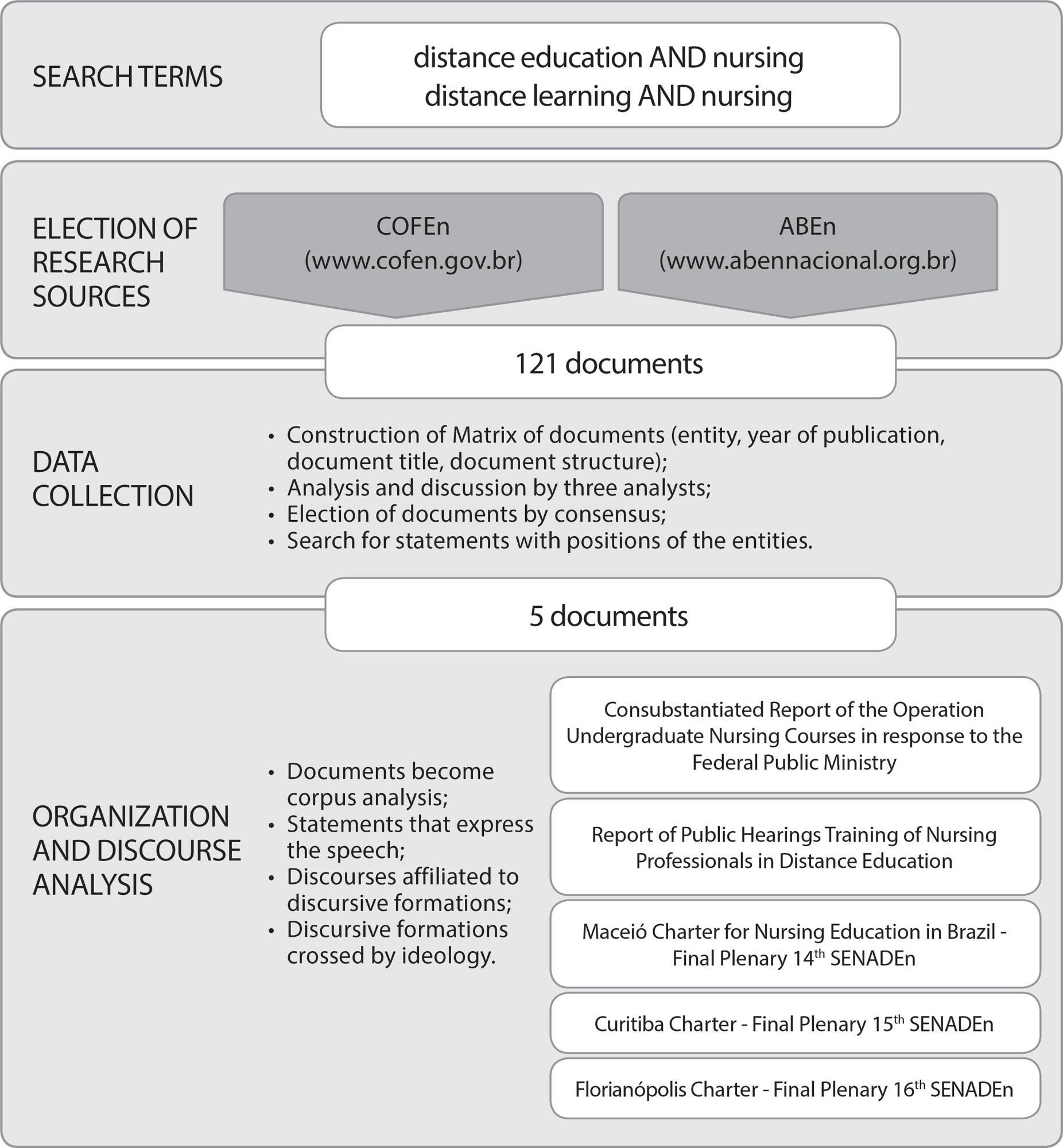
-
ARTÍCULO ORIGINAL13/07/2020
Culture of patient safety in hospital units of gynecology and obstetrics: a cross-sectional study
Revista Brasileira de Enfermagem. 2020;73(5):e20190576
Resumen
ARTÍCULO ORIGINALCulture of patient safety in hospital units of gynecology and obstetrics: a cross-sectional study
Revista Brasileira de Enfermagem. 2020;73(5):e20190576
DOI 10.1590/0034-7167-2019-0576
Visualizações0Ver maisABSTRACT
Objectives:
to assess the patient safety culture of the health team working in three maternity hospitals.
Methods:
observational, cross-sectional, comparative study. 301 professionals participated in the study. The Hospital Survey on Patient Safety Culture questionnaire validated in Brazil was used. For data analysis, it was considered a strong area in the patient safety culture when positive responses reached over 75%; and areas that need improvement when positive responses have reached less than 50%. To compare the results, standard deviation and thumb rule were used.
Results:
of the 12 dimensions of patient safety culture, none obtained a score above 75%, with nine dimensions scoring between 19% and 43% and three dimensions between 55% and 57%.
Conclusions:
no strong dimensions for safety culture were identified in the three maternity hospitals. It is believed that these results may contribute to the development of policies that promote a culture of safety in institutions.
-
ARTÍCULO DE REVISIÓN13/07/2020
The quality of life of family health professionals: a systematic review and meta-synthesis
Revista Brasileira de Enfermagem. 2020;73(5):e20190645
Resumen
ARTÍCULO DE REVISIÓNThe quality of life of family health professionals: a systematic review and meta-synthesis
Revista Brasileira de Enfermagem. 2020;73(5):e20190645
DOI 10.1590/0034-7167-2019-0645
Visualizações1Ver maisABSTRACT
Objectives:
to perform a systematic review and meta-synthesis of qualitative studies about the work-related quality of life of Family Health Strategy professionals.
Methods:
this systematic review was developed to answer the following PVO question: “Which factors (variables) are associated with the work-related quality of life (outcome) of Family Health Strategy professionals (population)?” The PubMed, Scopus, Embase, SciELO, Web of Science, LILACS, Science Direct, OpenThesis, OpenGrey, and OATD databases were selected. The meta-synthesis analyzed the main codes and secondary codes of all included studies.
Results:
the database search resulted in 1,744 reports; six were considered eligible for the meta-synthesis. Four factors were considered for the quality of work life: working conditions; work processes; interpersonal relationships; and personal aspects.
Conclusions:
although this study confirms the adequacy of aspects commonly related to the quality of work life, other factors are important in the case of FHS professionals, especially work context.
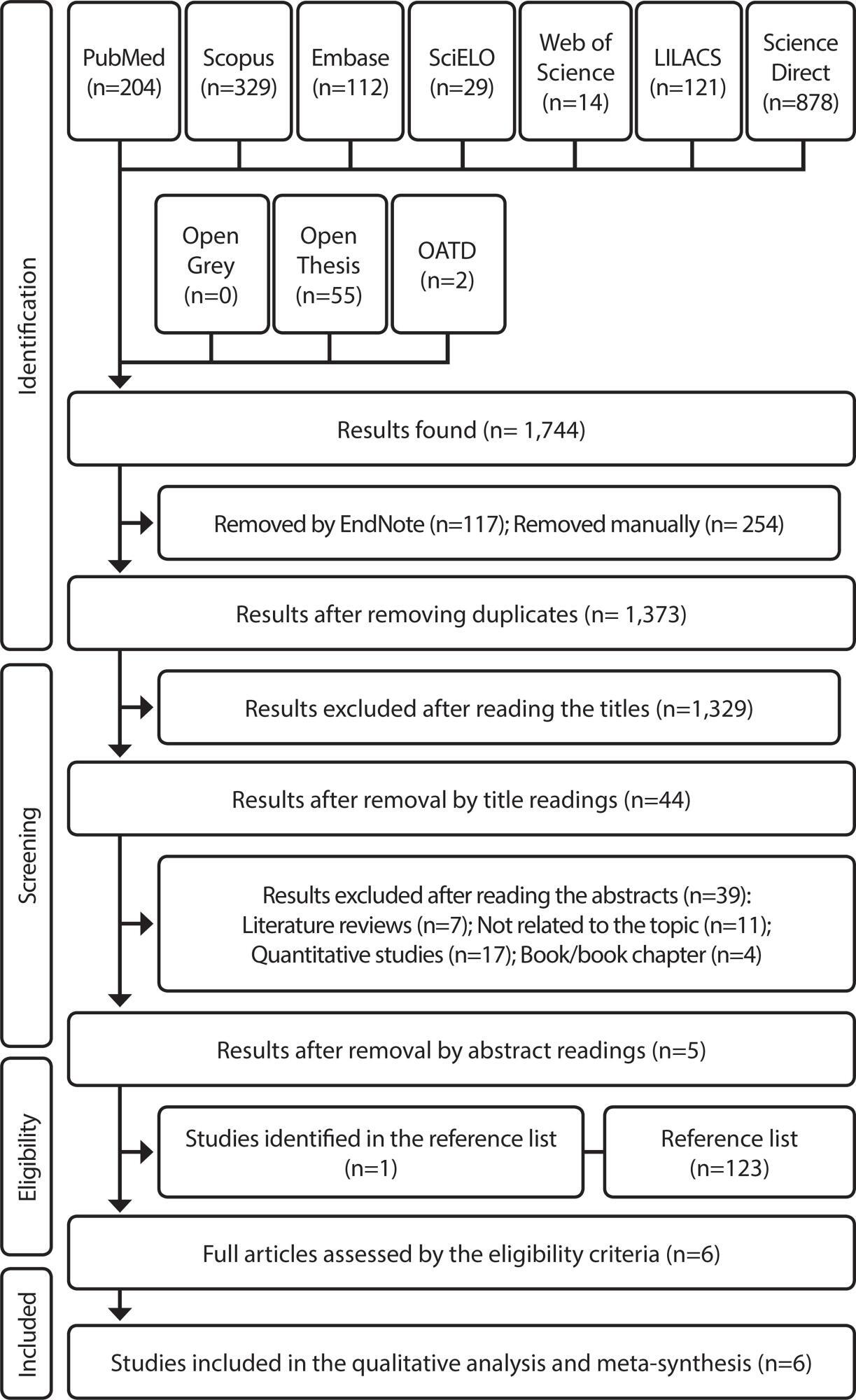
-
CARTA AL EDITOR01/07/2020
Letter to the Editor: doubts and considerations about Coronary Syndrome
Revista Brasileira de Enfermagem. 2020;73(5):e2020730502c
Resumen
CARTA AL EDITORLetter to the Editor: doubts and considerations about Coronary Syndrome
Revista Brasileira de Enfermagem. 2020;73(5):e2020730502c
DOI 10.1590/0034-7167.2020730502c
Visualizações0Dear Editor,We wrote this letter referring to the article “Impact of anxiety and depression on morbidity and mortality of patients with coronary syndrome”() to make some comments, in order to clarify doubts that we were missing from answering. We have already made it clear that our intention is not to question the work of the […]Ver mais -
ARTÍCULO ORIGINAL10/08/2020
Workers’ Health in Brazil: Accidents recorded by Social Security from 2008 to 2014
Revista Brasileira de Enfermagem. 2020;73(6):e20180892
Resumen
ARTÍCULO ORIGINALWorkers’ Health in Brazil: Accidents recorded by Social Security from 2008 to 2014
Revista Brasileira de Enfermagem. 2020;73(6):e20180892
DOI 10.1590/0034-7167-2018-0892
Visualizações0Ver maisABSTRACT
Objectives:
to analyze the incidence of occupational accidents in Brazil, recorded by Social Security according to the geographic regions, age group, gender and their prevalence according to the causes and branch of economic activity.
Methods:
ecological descriptive study with time series analysis from 2008 to 2014. Data on the beginning and end of the historical series were compared in each ecological unit studied.
Results:
the South and Southeast regions, male, between 20 and 49 years of age presented the highest falls in incidence. 70.87% of the causes occurred in group XIX of ICD-10. The economic activity with the highest prevalence of accidents was the manufacturing industry.
Conclusions:
accidents at work have decreased in Brazil, however, the incidence is still high. Advances need to be made in the recording of accidents and in the prevention and surveillance of workers’ health.
-
ARTÍCULO ORIGINAL10/08/2020
Neonatal near miss in the intensive care unit
Revista Brasileira de Enfermagem. 2020;73(6):e20180931
Resumen
ARTÍCULO ORIGINALNeonatal near miss in the intensive care unit
Revista Brasileira de Enfermagem. 2020;73(6):e20180931
DOI 10.1590/0034-7167-2018-0931
Visualizações0Ver maisABSTRACT
Objective:
To analyze near miss cases among newborns hospitalized in the Intensive Care Unit.
Methods:
An observational, cross-sectional, retrospective study using the STROBE guideline. Data were collected from 1,101 records of live births (newborns). Statistical analysis used the Epi-Info program 3.3.2 and Chi-square and Fisher’s exact tests.
Results:
A total of 162 newborns were hospitalized, of which 63 had at least one criterion of near miss. The variables that remained associated with neonatal near miss were weight <1.750 g, gestational age <33 weeks and Apgar at 5 minutes <7, pragmatic criteria to identify cases of neonatal near miss morbidity.
Conclusion:
Prematurity and low birth weight were the factors that contributed most to the near miss outcome among newborns hospitalized in intensive care, a rate two and a half times higher than the number of deaths, according to scientific evidence.

-
10/08/2020
Care for the critical patient undergoing point-of-care testing: integrative review
Revista Brasileira de Enfermagem. 2020;73(6):e20180948
Resumen
Care for the critical patient undergoing point-of-care testing: integrative review
Revista Brasileira de Enfermagem. 2020;73(6):e20180948
DOI 10.1590/0034-7167-2018-0948
Visualizações0Ver maisABSTRACT
Objective:
to identify, based on the evidence, point-of-care testing in bedbound in critically ill patients.
Method:
integrative review, carried out through search in Pubmed, Virtual Health Library, Joanna Briggs Institute, The British Institute of Radiology, Brazilian Radiology, and Google Scholar databases. We used the PICO research strategy and selected articles published from 2013 onwards, which presented information about point-of-care testing.
Results:
the different interventions found in the analysis of the 23 selected articles allowed the thematic grouping of care related to safety in communication, patient identification, care with devices, and the prevention and control of infection, which can be used in point-of-care testing.
Final considerations:
The care described in the evidence provided support for validating a safe care protocol for critically ill patients undergoing imaging studies in bed.
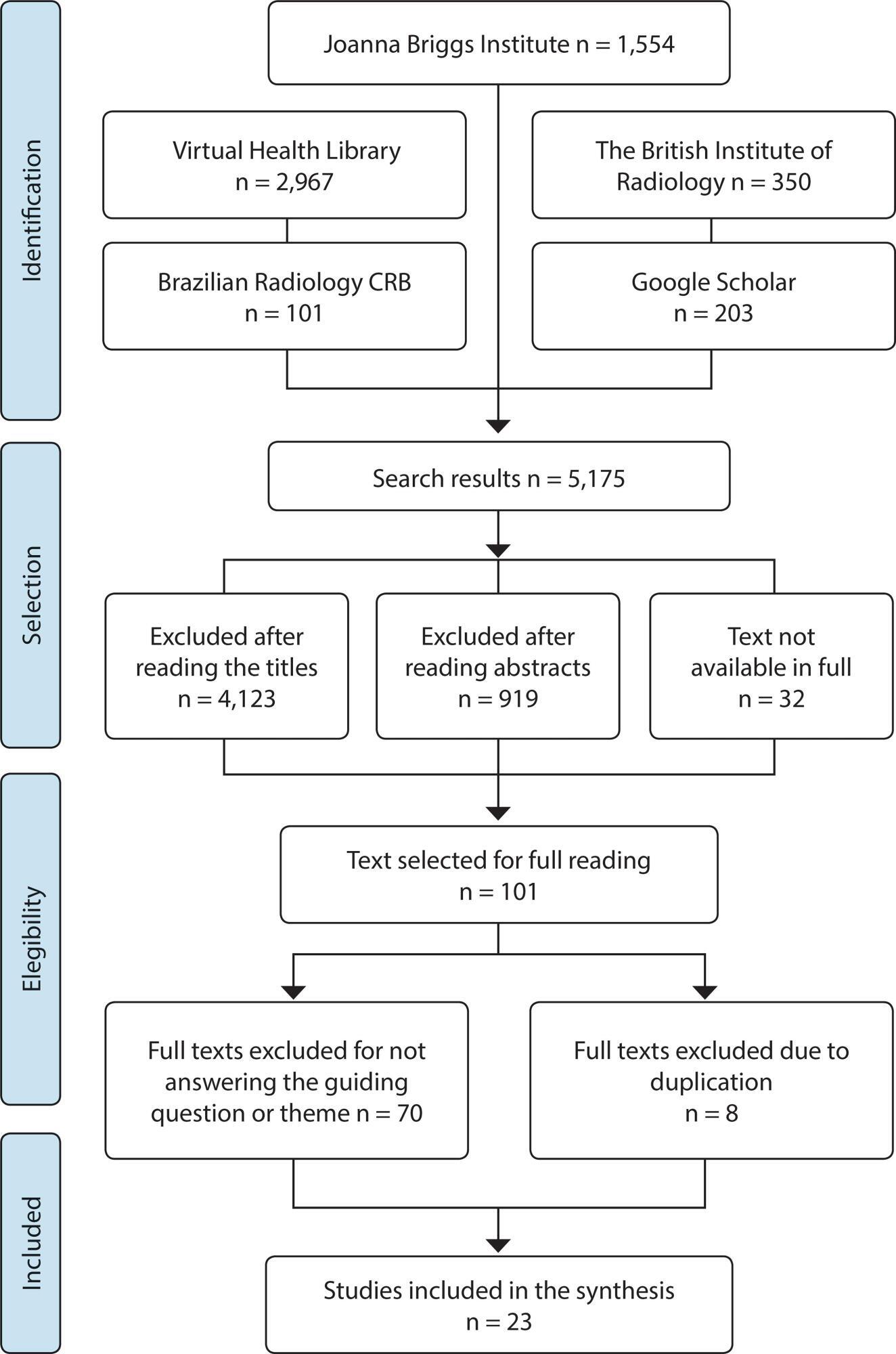
-
14/04/2021
Child behavior during the social distancing in the COVID-19 pandemic
Revista Brasileira de Enfermagem. 2021;74:e20200762
Resumen
Child behavior during the social distancing in the COVID-19 pandemic
Revista Brasileira de Enfermagem. 2021;74:e20200762
DOI 10.1590/0034-7167-2020-0762
Visualizações0Ver maisABSTRACT
Objective:
To describe the daily activities performed by children from 6 to 12 years of age incomplete and analyze children’s behavior during social distancing in the face of the COVID-19 pandemic.
Methods:
Cross-sectional study with children in a learning stage living in Brazil. The data were collected via online form. Fisher’s exact test was applied to analyze the association of categorical variables with child behavior; when significant, it was used the odds ratio. It was considered results considered statistically significant those presenting values of p < 0.05.
Results:
Data from 530 children were analyzed: 50.3% female, 71.3% from the Southeast Region, 73% in fulltime social distancing, 52% presented anxiety, which was significantly associated with changes in sleep and appetite.
Conclusion:
The results indicate the need for parents/caretakers to stimulate moments for the child to express themselves, not minimizing their feelings and providing emotional support to mitigate the negative impact of these feelings on the child’s mental and physical health.
-
05/12/2019
Hospital care and urinary incontinence in the elderly
Revista Brasileira de Enfermagem. 2019;72:284-293
Resumen
Hospital care and urinary incontinence in the elderly
Revista Brasileira de Enfermagem. 2019;72:284-293
DOI 10.1590/0034-7167-2018-0273
Visualizações0Ver maisABSTRACT
Objective:
to identify factors inherent in hospital care that favor urinary incontinence in the elderly.
Method:
an integrative review with Scopus, CINAHL and Pubmed searches. Includes original articles, no language restriction, published between 2008 and 2018. Rated level of recommendation and level of evidence were assessed using the Oxford Center for Evidence-Based Medicine classification. Exploited content through thematic analysis in light of the Donabedian model.
Results:
13 articles constituted the sample. There were factors such as the unjustified and indiscriminate use of devices such as the geriatric diaper; hospital structure adversely affecting the needs of the elderly; and deficit in screening, risk identification and underreporting of the problem favor urinary incontinence in the hospitalized elderly.
Conclusion:
modifiable factors related to hospital structures and care processes favor both the onset and worsening of urinary incontinence in the elderly.
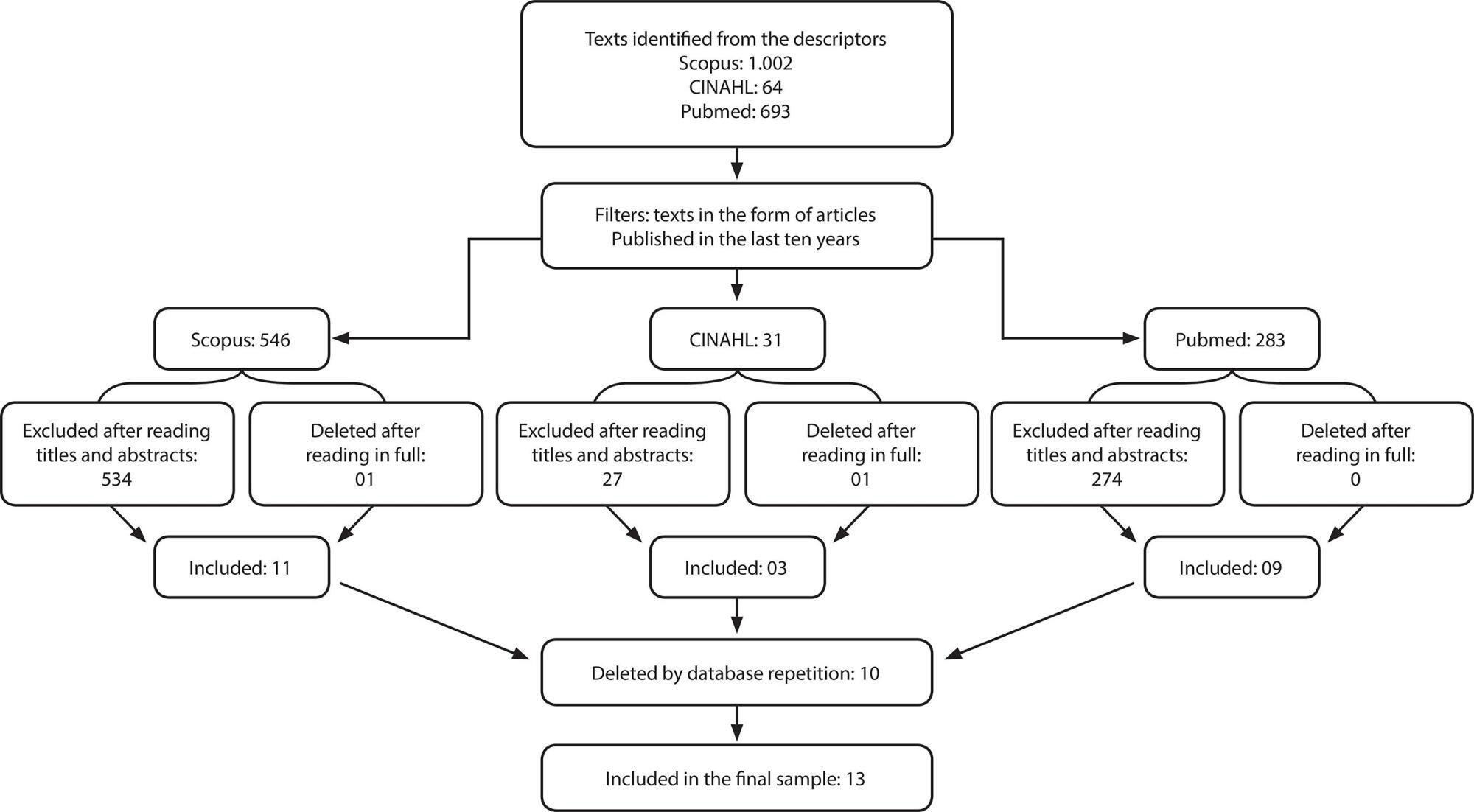
-
ARTÍCULO ORIGINAL21/10/2019
Hipermídia educativa sobre assistência de enfermagem ao parto: construção e validação de conteúdo e aparência
Revista Brasileira de Enfermagem. 2019;72(6):1471-1478
Resumen
ARTÍCULO ORIGINALHipermídia educativa sobre assistência de enfermagem ao parto: construção e validação de conteúdo e aparência
Revista Brasileira de Enfermagem. 2019;72(6):1471-1478
DOI 10.1590/0034-7167/2018-0163
Visualizações1Ver maisRESUMO
Objetivo:
construir uma hipermídia educativa sobre a assistência de enfermagem ao parto de risco habitual e realizar a validação de conteúdo e de aparência.
Método:
pesquisa metodológica, realizada seguindo as seguintes etapas: levantamento do conteúdo e planejamento dos módulos; produção das mídias e organização das unidades tutoriais; organização do espaço do aluno, tutor e de comunicação entre eles; elaboração da hipermídia; disponibilização da hipermídia; avaliação por especialistas em Enfermagem e Informática; e implementação das sugestões propostas.
Resultados:
a hipermídia educativa mostrou-se como um material validado, visto que apresentou um ótimo índice de validade de conteúdo global de 0,97 e significância estatística no teste binomial para o conteúdo e aparência.
Conclusão:
acredita-se que o uso deste material com alunos da graduação em Enfermagem contribuirá com a qualidade da assistência obstétrica, tendo em vista que se constitui em uma tecnologia ilustrada capaz de favorecer o ensino-aprendizagem sobre parto normal humanizado.
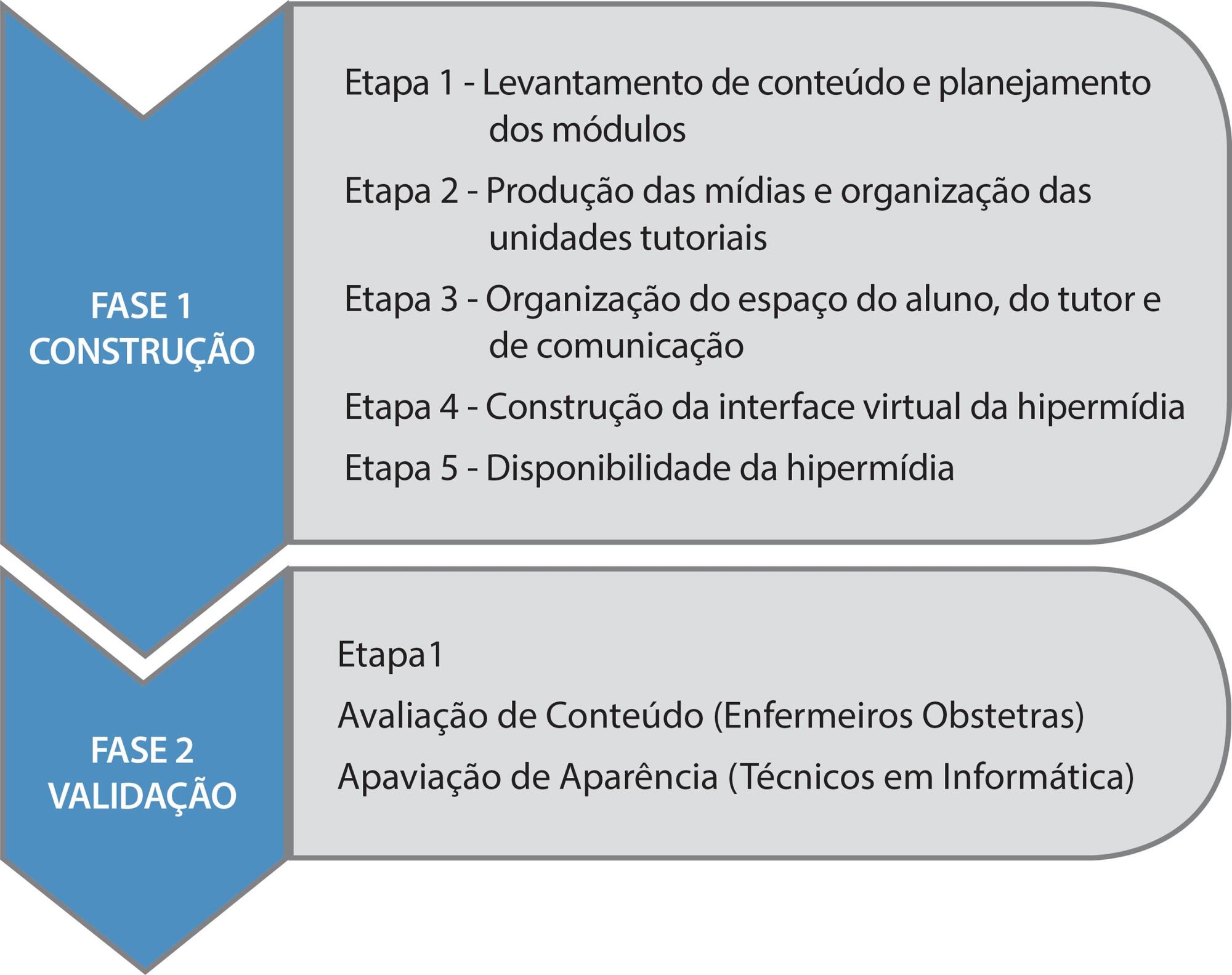
-
ARTÍCULO ORIGINAL30/03/2020
Boas Práticas de segurança nos cuidados de enfermagem em Terapia Intensiva Neonatal
Revista Brasileira de Enfermagem. 2020;73(2):e20180482
Resumen
ARTÍCULO ORIGINALBoas Práticas de segurança nos cuidados de enfermagem em Terapia Intensiva Neonatal
Revista Brasileira de Enfermagem. 2020;73(2):e20180482
DOI 10.1590/0034-7167-2018-0482
Visualizações0RESUMO
Objetivos:
identificar a percepção dos profissionais de enfermagem sobre o erro humano nos cuidados de enfermagem na Unidade de Terapia Intensiva Neonatal; analisar as estratégias de Boas Práticas propostas por esses profissionais para a segurança do paciente nos cuidados de enfermagem.
Métodos:
estudo quanti-qualitativo, descritivo. Cenário: Unidade de Terapia Intensiva Neonatal. Participantes: 22 profissionais de enfermagem. Coleta dos dados realizada por meio de entrevistas e submetidos a análise temática.
Resultados:
erro humano nos cuidados de enfermagem, identificando-se perdas de cateteres e erros no processo de medicação; causas para o erro nos cuidados de enfermagem, destacando-se a sobrecarga de trabalho; Boas Práticas para a segurança do paciente nos cuidados de enfermagem, como capacitação profissional e melhorias das condições de trabalho.
Conclusões:
demonstra-se a importância de investir em estratégias de Boas Práticas para a Segurança do Paciente, buscando-se sedimentar a cultura de segurança organizacional e estimular um ambiente propício ao gerenciamento do erro.
Palavras-chave: EnfermagemErros MédicosGestão de SegurançaSegurança do PacienteUnidades de Terapia Intensiva NeonatalVer mais -
ARTÍCULO DE REVISIÓN29/09/2022
Nursing students’ learning from involvement in research projects: an integrative literature review
Revista Brasileira de Enfermagem. 2022;75(1):e20210053
Resumen
ARTÍCULO DE REVISIÓNNursing students’ learning from involvement in research projects: an integrative literature review
Revista Brasileira de Enfermagem. 2022;75(1):e20210053
DOI 10.1590/0034-7167-2021-0053
Visualizações0Ver maisABSTRACT
Objective:
To identify the learning outcomes and skills obtained of undergraduate nursing students involved in research projects.
Methods:
This was an integrative literature review, based on a research protocol in the CINAHL Complete databases; Cochrane Central Register of Controlled Trials; Cochrane Database of Systematic Reviews; Cochrane Methodology Register; MedicLatina; MEDLINE, Scopus and JBI, including primary and secondary studies, published between 2015 and 2020.
Results:
A total of five heterogeneous articles were included, which were categorized using Kirkpatrick’s (adapted) model. Seventeen learning outcomes acquired through participation in research projects were identified, from the learning of new knowledge and skills to the development of new attitudes and behaviors.
Final considerations:
The involvement of nursing students in research projects is important to their professional development. Future investment in research on this topic can help cement the potential of this type of student involvement.
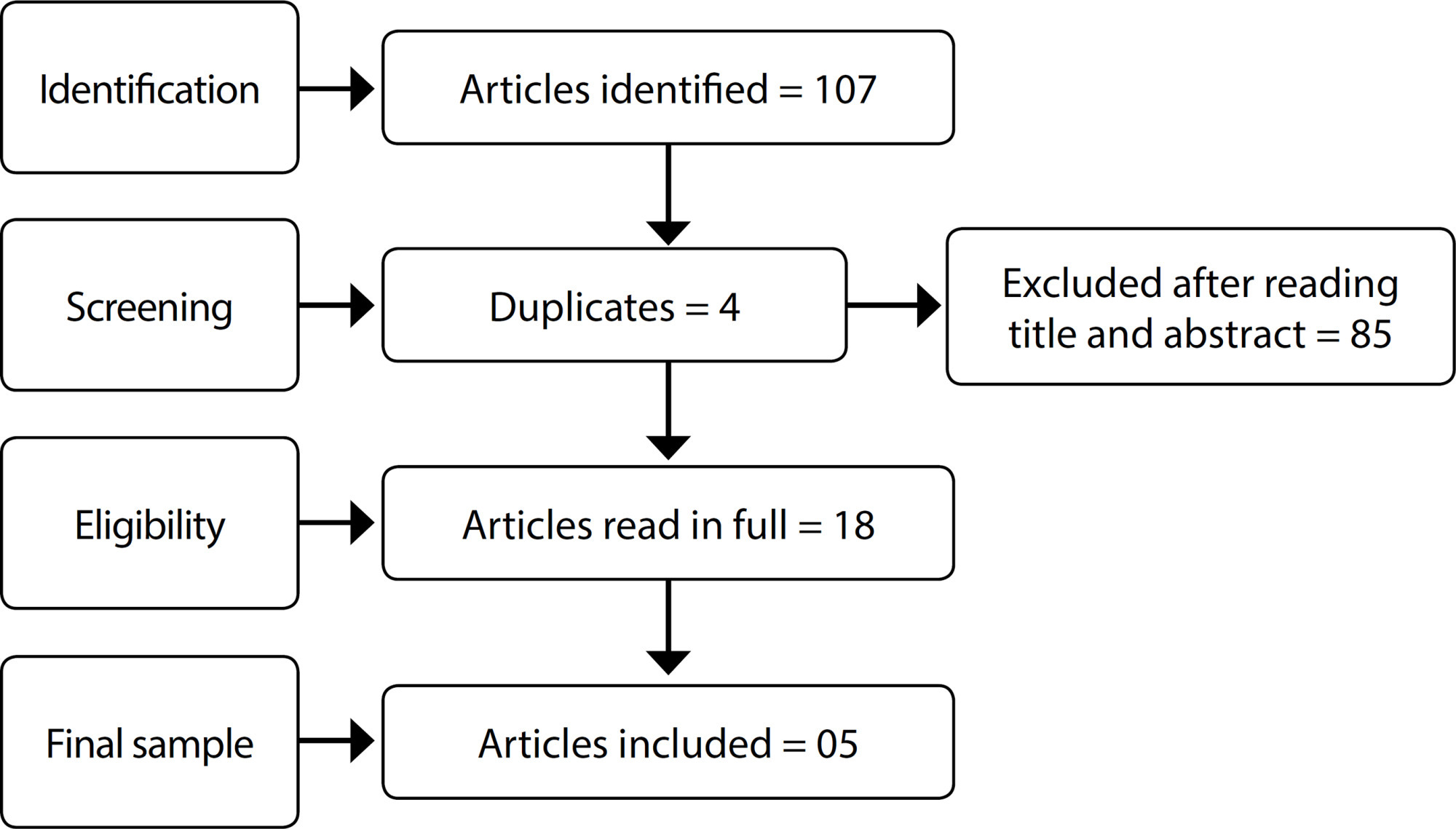
-
ARTÍCULO ORIGINAL05/12/2019
Qualidade de vida relacionada à saúde em pacientes com insuficiência cardíaca
Revista Brasileira de Enfermagem. 2019;72:140-146
Resumen
ARTÍCULO ORIGINALQualidade de vida relacionada à saúde em pacientes com insuficiência cardíaca
Revista Brasileira de Enfermagem. 2019;72:140-146
DOI 10.1590/0034-7167-2018-0368
Visualizações1RESUMO
Objetivo:
Avaliar a qualidade de vida relacionada à saúde dos pacientes com insuficiência cardíaca e relacionar aos dados sociodemográficos e clínicos.
Método:
Trata-se de estudo observacional, de corte transversal, com abordagem quantitativa realizado em ambulatório de insuficiência cardíaca no estado de Pernambuco.
Resultados:
Na amostra (n=101) houve predominância de homens, maiores de 60 anos, casados, profissionalmente inativos. A qualidade de vida relacionada à saúde, a partir do questionário Minnesota Living With Heart Failure Questionnaire foi considerada moderada (34,3±21,6), apresentando relação significativa com idade (p=0,004), classe funcional (p<0,001) e em pacientes com cardiopatia chagásica (p=0,02).
Conclusão:
A qualidade de vida no grupo IC de etiologia chagásica esteve mais comprometida, especialmente na dimensão emocional. Sugere-se a realização de estudos abordando as hipóteses de que maior tempo de acompanhamento ambulatorial melhora a qualidade de vida e que ter doença de Chagas interfere negativamente na qualidade de vida de pacientes com insuficiência cardíaca.
Palavras-chave: Assistência AmbulatorialDoença de ChagasEnfermagemInsuficiência CardíacaQualidade de VidaVer mais -
ARTÍCULO DE REVISIÓN21/12/2020
Aplicação da metodologia Lean Seis Sigma nos cenários de assistência à saúde: revisão integrativa
Revista Brasileira de Enfermagem. 2020;73:e20190861
Resumen
ARTÍCULO DE REVISIÓNAplicação da metodologia Lean Seis Sigma nos cenários de assistência à saúde: revisão integrativa
Revista Brasileira de Enfermagem. 2020;73:e20190861
DOI 10.1590/0034-7167-2019-0861
Visualizações0RESUMO
Objetivo:
analisar a produção científica sobre os resultados da metodologia Lean Six Sigma nas instituições de assistência à saúde.
Métodos:
revisão integrativa da literatura, com a seguinte pergunta: quais são os resultados nas instituições de saúde com a utilização da metodologia Lean Six Sigma e Six Sigma? A busca foi realizada nas bases de dados MEDLINE, LILACS, BDENF, CINAHL, Web of Science e Scopus, sem recorte temporal.
Resultados:
foram incluídos 34 artigos, publicados entre 2005 e 2019, sendo 52,9% provenientes dos Estados Unidos da América. As melhorias mais comumente encontradas foram em instituições hospitalares e na perspectiva dos clientes e processos internos.
Conclusão:
a utilização da metodologia Lean Six Sigma se demonstrou eficaz nos diversos cenários de assistência à saúde, se destacando uma lacuna em sua aplicação quanto ao engajamento e capacitação de pessoas.
Palavras-chave: Administração em SaúdeAssistência à SaúdeControle de QualidadeGestão da Qualidade TotalMelhoria de QualidadeVer mais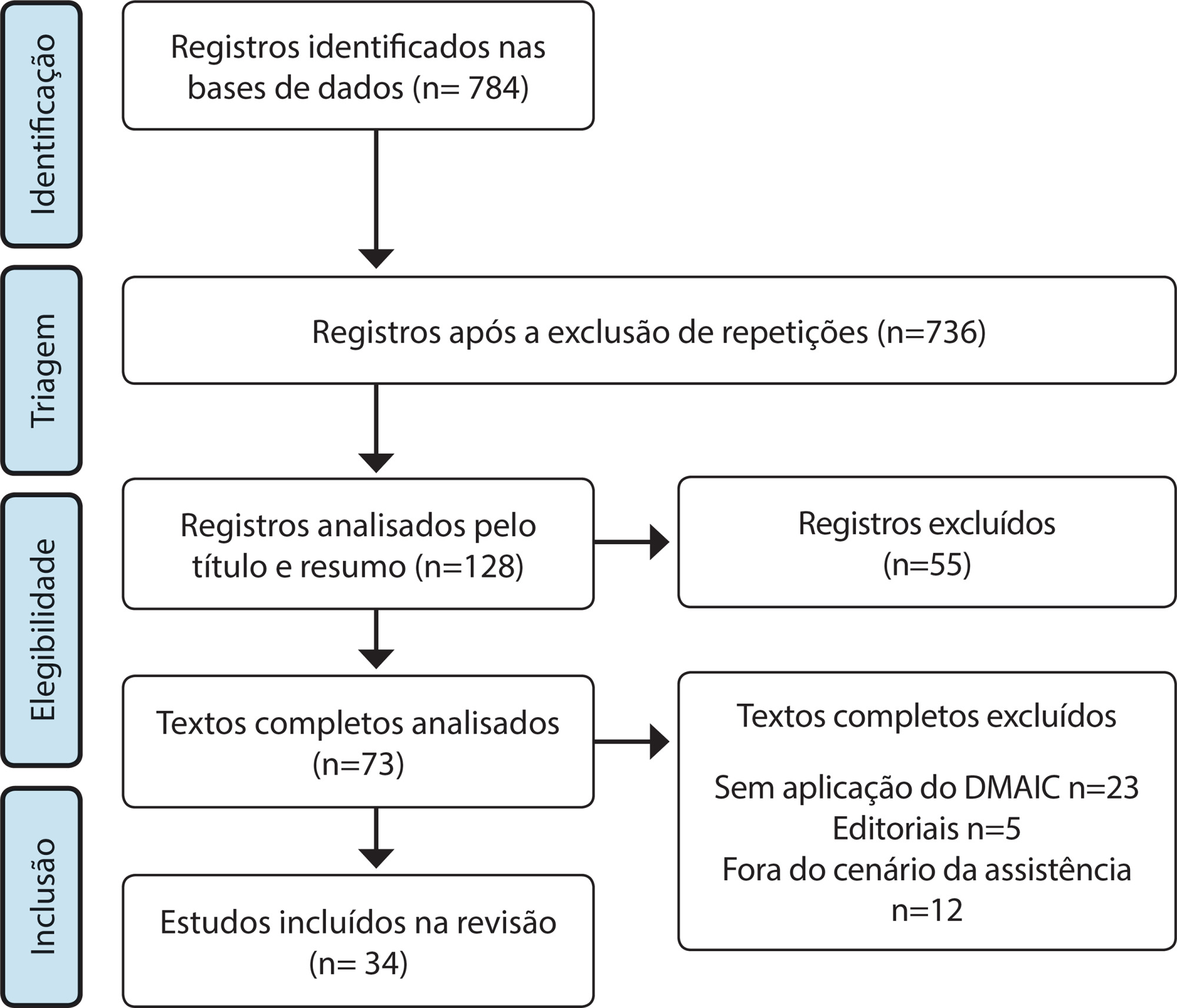
-
ARTÍCULO ORIGINAL17/02/2020
Análise dos registros de técnicos de enfermagem e enfermeiros em prontuários
Revista Brasileira de Enfermagem. 2020;73(2):e20180542
Resumen
ARTÍCULO ORIGINALAnálise dos registros de técnicos de enfermagem e enfermeiros em prontuários
Revista Brasileira de Enfermagem. 2020;73(2):e20180542
DOI 10.1590/0034-7167-2018-0542
Visualizações0RESUMO
Objetivos:
analisar as principais não conformidades dos registros de enfermagem de um hospital público do Nordeste na cidade de Natal.
Métodos:
estudo descritivo, transversal, abordagem quantitativa. Realizado em enfermarias médicas e cirúrgicas. Amostra composta de 120 prontuários de pacientes internados entre outubro e dezembro de 2016. Os dados obtidos foram tabulados e analisados por estatística simples em frequência absoluta e relativa com o software Microsoft Excel 2013. Para avaliar as não conformidades dos registros, usou-se o Diagrama de Pareto.
Resultados:
como principais problemas nos registros de enfermagem, destacou-se a ausência da categoria profissional e número do conselho, responsáveis por 41,8% das não conformidades nos registros de técnicos de enfermagem, enquanto nas anotações dos enfermeiros foram a ausência de hora e as letras ilegíveis, com 61,2%.
Conclusões:
o estudo evidenciou que os profissionais de enfermagem realizam seus registros de forma incompleta e que muitas vezes não documentam o cuidado prestado.
Palavras-chave: ComunicaçãoEnfermagemPesquisa sobre Serviços de SaúdeRegistros de EnfermagemSegurança do PacienteVer mais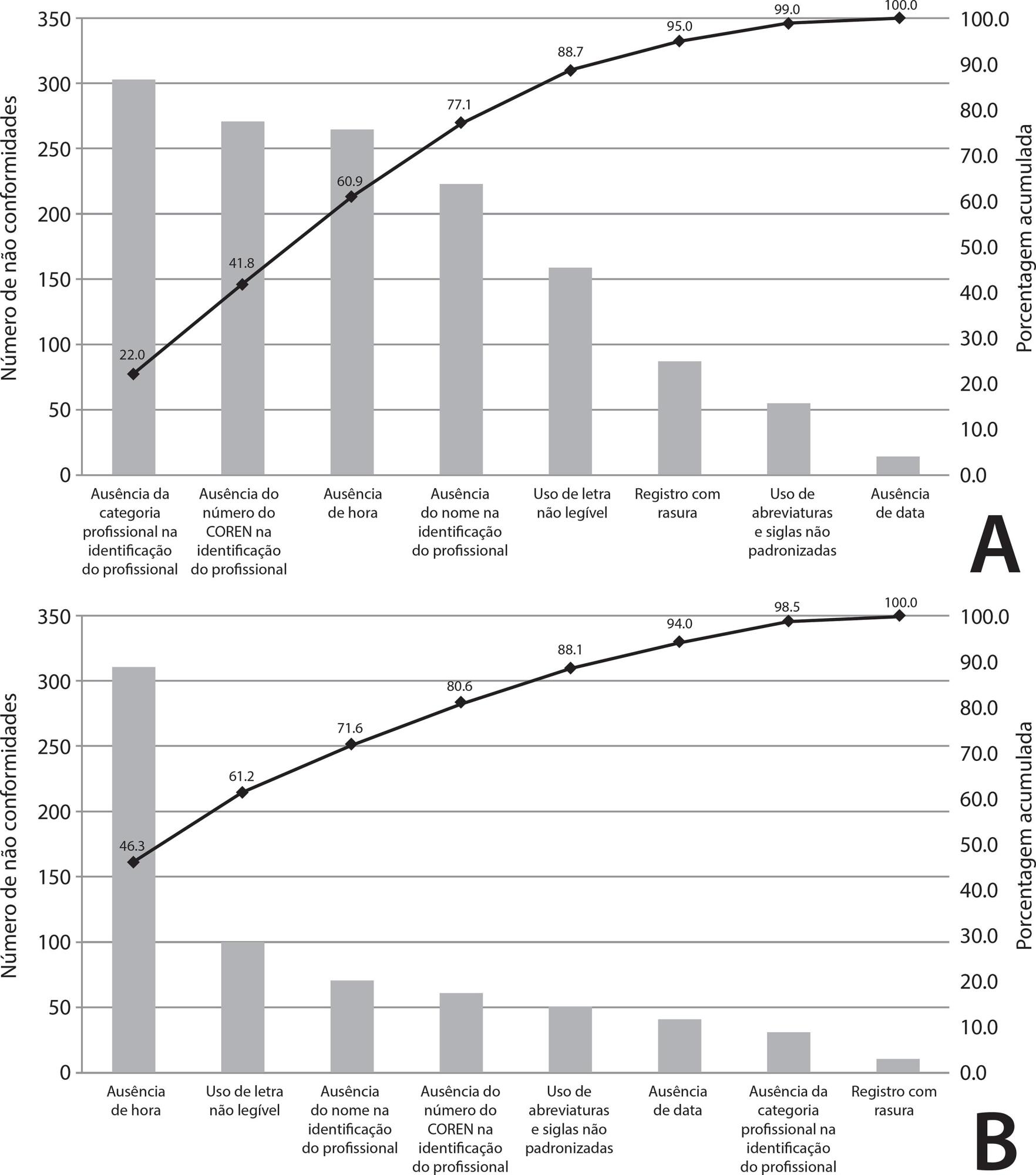
Búsqueda
Buscar en:
Nuvem de Tags
Adolescente (85) Atenção Primária à Saúde (239) COVID-19 (91) Criança (91) Cuidados de Enfermagem (269) Educação em Enfermagem (151) Educação em Saúde (139) Enfermagem (930) Enfermagem Pediátrica (86) Estudantes de Enfermagem (77) Estudos de Validação (131) Família (87) Idoso (208) Promoção da Saúde (99) Qualidade de Vida (104) Saúde do Trabalhador (86) Saúde Mental (145) Saúde Pública (82) Segurança do Paciente (150) Tecnologia Educacional (100)



